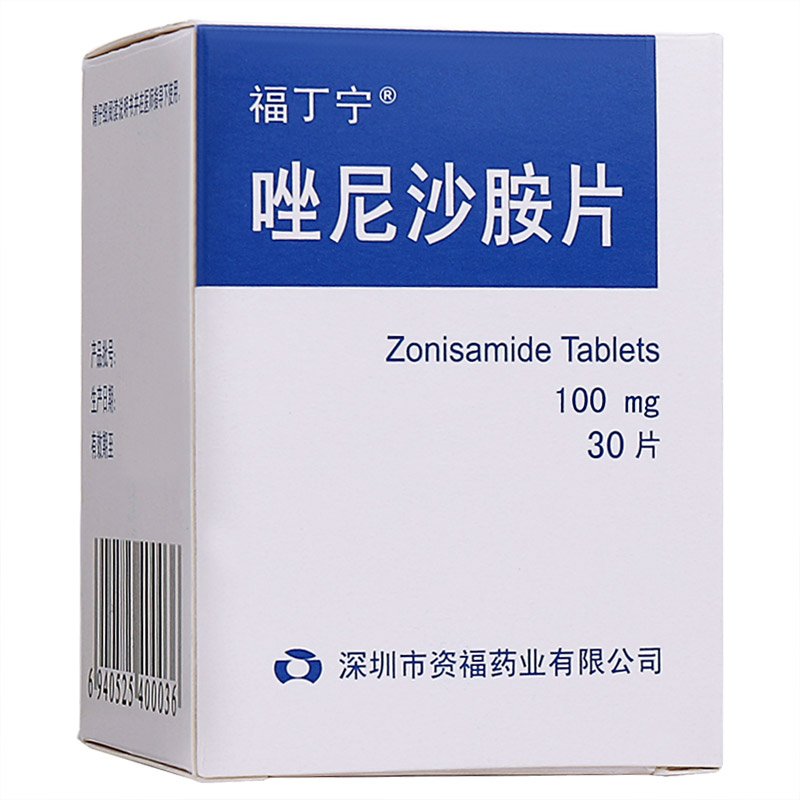Zonisamide Tablets.
Effects and efficacy:
Zonisamide is mainly used as an add-on treatment for partial seizures in adults.
Usage and dosage:
Zonisamide is taken orally, and the specific dosage should be prescribed by the doctor. The same drugs produced by different manufacturers may have inconsistent instructions. If you find inconsistencies in the instructions before taking the medicine, please consult your doctor or pharmacist in time. Take 1 to 2 times a day. The initial dose should be 100 mg per day, which can be increased to 200 mg/day after two weeks, and then increased to 300 mg/day or even 400 mg/day after two weeks. Each dose should be continued for at least two weeks to reach steady state. Prescribers should note that many adverse reactions of zonisamide are more common at doses of 300 mg or higher per day. Although there is some evidence that the efficacy is better when the dose is higher than 100-200 mg/day, the increase in efficacy is small, and no formal dose-response studies have been conducted.
Adverse reactions:
In controlled clinical trials, the adverse reactions with a frequency of at least 2% in the zonisamide treatment group are as follows, and the intensity of adverse events is usually mild or moderate. Body: Headache, abdominal pain, flu symptoms. Digestive system: Anorexia, nausea, diarrhea, indigestion, constipation, dry mouth. Blood and lymphatic system: Ecchymosis. Metabolism and nutrition: Weight loss. Nervous system: Dizziness, ataxia, nystagmus, paresthesia. Neuropsychiatric and cognitive dysfunction: Confusion, inattention, memory loss, slow thinking, irritability, depression, insomnia, anxiety, nervousness, schizophrenia/schizophrenia-like behavior, drowsiness, fatigue, tiredness, abnormal speech, difficulty in speaking. Respiratory system: Rhinitis. Skin and appendages: Rash. Special senses: Diplopia, taste perversion. Other adverse events that occurred in clinical trials are as follows: Common, occurring in at least 1% of patients; Uncommon, occurring in less than 1% but more than 0.1% of patients; Rare, occurring in less than 0.1% of patients. Body: Common adverse events, accidental injury and asthenia. Rare adverse events: chest pain, rib pain, discomfort, allergic reaction, facial edema and stiff neck. Rare adverse events: lupus erythematosus. Cardiovascular system: Rare adverse events: palpitations, tachycardia, vascular insufficiency, hypotension, hypertension, thrombophlebitis, syncope and bradycardia. Rare adverse events: atrial fibrillation, heart failure, pulmonary embolism and premature ventricular contractions. Digestive system: Common adverse events: vomiting. Rare adverse events: flatulence, gingivitis, gingival hyperplasia, gastritis, gastroenteritis, stomatitis, cholelithiasis, glossitis, melena, rectal bleeding, ulcerative stomatitis, gastroduodenal ulcer, dysphagia, gingival bleeding. Rare adverse events: cholangitis, hemoptysis, cholecystitis, cholestatic jaundice, colitis, duodenitis, esophagitis, fecal incontinence and oral ulcers. Blood and lymphatic system: Common adverse events: leukopenia, anemia, immunodeficiency and lymphadenopathy. Rare adverse events: thrombocytopenia, microcytic anemia, and ecchymosis. Metabolism and Nutrition: Rare adverse events: peripheral edema, weight gain, edema, thirst, and dehydration. Rare adverse events: hypoglycemia, hyponatremia, increased lactate deoxygenase, increased AST, and increased ALT. Musculoskeletal system: Rare adverse events: leg cramps, myalgia, myasthenia, arthralgia, and arthritis. Nervous system: Common adverse events: tremor, convulsions, abnormal gait, hyperesthesia, and ataxia. Rare adverse events: hypertonia, twitching, abnormal dreams, vertigo, decreased libido, neuropathy, hyperkinesia, ataxia, dysarthria, stroke syndrome, hypotonia, peripheral neuritis, paresthesia, and increased reflexes. Rare adverse events: perioral paresthesia, dyskinesia, dystonia, encephalopathy, facial nerve palsy, hypokinesia, hyperesthesia, myoclonus, and oculomotor crisis. Abnormal behavior (non-neurological related): Rare adverse event: euphoria. Respiratory system: Common adverse events: pharyngitis and increased cough. Rare adverse events: dyspnea. Rare adverse events: apnea and hemoptysis. Skin and appendages: Common adverse events: pruritus. Rare adverse events: maculopapular rash, acne, alopecia, dry skin, sweating, eczema, urticaria, hirsutism, pustular rash and vesicles, bullous rash. Special senses: Common adverse events: amblyopia and tinnitus. Rare adverse events: conjunctivitis, parosmia, deafness, visual field loss and glaucoma. Rare adverse events: photophobia and iritis. Urogenital system: Common adverse events: frequent urination, dysuria, enuresis, hematuria, impotence, urinary retention, urgency, amenorrhea, polyuria and nocturia. Rare adverse events: proteinuria, urinary incontinence, bladder pain, bladder stones, gynecomastia, mastitis and menorrhagia. Others: Severe reactions to zonisamide include Stevens-Johnson syndrome, toxic epidermal necrolysis, fulminant hepatic necrosis, agranulocytosis, aplastic anemia, and other blood disorders. There may also be kidney stones, abnormal renal function, unexplained sudden death, status epilepticus, and hypohidrosis and fever in pediatric patients.
Drug contraindications:
Allergic to this product, prohibited from driving, use with caution, use with caution during lactation, use with caution during pregnancy
Share:
Products
Our offers
Health Classification
Let us work together to protect precious health



























